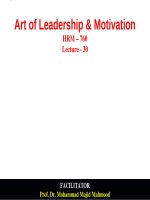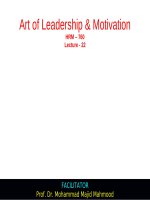Lecture Art of Leadership and Motivation - Lecture 32
Bạn đang xem bản rút gọn của tài liệu. Xem và tải ngay bản đầy đủ của tài liệu tại đây (2.37 MB, 58 trang )
Art of Leadership & Motivation
HRM – 760
Le c ture 32
FACILITATOR
Prof. Dr. Mohammad Majid Mahmood
Review of
Art of Leadership & Motivation
2
Learning Objectives
• Upon completion of this course, students should be able to:
• Explore questions such as: who are you as a leader, what do
you want to accomplish, what issues are you passionate
about, and what is your personal leadership definition;
• Understand and conceptually be able to discuss traditional
and emerging leadership theories;
3
Learning Objectives
• Critically analyze past and current leadership experiences;
and
• Apply leadership theory to practice to enhance leadership
skills, experience and knowledge.
4
Leadership
"Leadership is constantly changing, and
survivors learn to change with it."
"Yesterday, natural resources defined power. Today,
knowledge is power.
Yesterday, leaders commanded and controlled.
Today, leaders empower and coach.
Yesterday, leaders were warriors. Today, they are
facilitators.
Yesterday, leaders directed. Today, leaders
delegate.
Dr. Denis Waitley
The Toastmaster, 2012
5
Leadership
“
If your actions inspire
others to dream more,
learn more, do more,
and become more, you
are a leader”
-
Leadership is the influencing
process of leaders and followers
to achieve organizational
objectives through change
7
Workforce Management
Management is more
than getting work done through people. It is
developing people through work. If you want to
improve your workforce management, then
you need to improve the way you lead people.
L E A D E R S H I P is about
influence…
““ The process of influencing others to understand and
agree about what needs to be done and how to do it, and
the process of facilitating individual and collective efforts to
accomplish shared objectives” (Yuk, 2006).
9
Leadership occurs…. anywhere
10
Leader Effectiveness
What
results would we expect to see from a
“good” leader:
◦Performance (the job gets done)
◦Motivation (followers are energized)
◦Effort (followers try hard)
◦Satisfaction (followers are happy)
11
Communication
High energy
Dominance
Selfconfident
Judgement
Skills of
Effective
Leaders
Stability
Flexibility
Sensitivity
to others
Intelligence
12
Lifelong Learning Journey
DEVELOPING YOUR LEADERSHIP SKILLS
13
1
Lead by
Example
And provide recognition when
others do the same!
14
2
Build Strong
Relationships
with your employees, respecting
their abilities & contributions, and
demonstrating trust &
attentiveness to their needs.
15
3
Communicate
Effectively
Communication is a two-way
street.
16
4
Build Team
Spirit
Encourage and reward
collaboration and innovation on a
regular basis.
17
5
Set Goals
that are clear, specific and
measurable. Communicate the
goals to your team, in ways and
words that they understand.
18
6
Understand the
Finances
documenting staff progress and
success – looking for ways to save
the company money is always a
good idea.
19
7
Encourage the
Team
by creating an environment in which people receive recognition for work
done well, where employees are motivated to work hard for the success of
the organization.
20
8
Help People
Grow
their skills and strengths through
education and on-the-job training
programs.
21
9
Provide Quality
Training
that will lead to confident and productive employees – their success will
often lead them to become better leaders.
22
10
Keep the
Dream Alive
by sharing the vision of the company with the team and then,
together, putting the dream into action…every single day.
23
Motivation
• People vary in their ability to do an activity and in
their willingness to do it.
• Motivation is the willingness aspect.
(Hersey & Blanchard)
24
The
Performance
Formula
25









